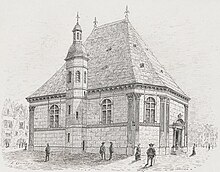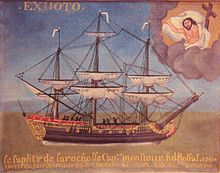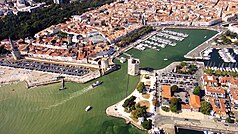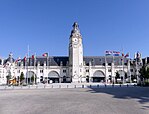La Rochelle
You can help expand this article with text translated from the corresponding article in French. (June 2020) Click [show] for important translation instructions.
|
La Rochelle
La Rochèla ( Prefecture and commune | |
|---|---|
| Coordinates: 46°10′N 1°09′W / 46.16°N 1.15°W | |
| Country | France |
| Region | Nouvelle-Aquitaine |
| Department | Charente-Maritime |
| Arrondissement | La Rochelle |
| Intercommunality | CA La Rochelle |
| Government | |
| • Mayor (2020–2026) | Jean-François Fountaine[1] |
| Area 1 | 28.43 km2 (10.98 sq mi) |
| Population (2021)[2] | 78,535 |
| • Density | 2,800/km2 (7,200/sq mi) |
| Time zone | UTC+01:00 (CET) |
| • Summer (DST) | UTC+02:00 (CEST) |
| INSEE/Postal code | 17300 /17000 |
| Elevation | 0–28 m (0–92 ft) (avg. 4 m or 13 ft) |
| 1 French Land Register data, which excludes lakes, ponds, glaciers > 1 km2 (0.386 sq mi or 247 acres) and river estuaries. | |
La Rochelle (
Situated on the edge of the Atlantic Ocean the city is connected to the Île de Ré by a 2.9-kilometre-long (1+3⁄4-mile) bridge completed on 19 May 1988. Since the Middle Ages the harbour has opened onto a protected strait, the Pertuis d'Antioche and is regarded as a "Door océane" or gateway to the ocean because of the presence of its three ports (fishing, trade and yachting). The city has a strong commercial tradition, having an active port from very early on in its history.
The city traces its origins to the Gallo-Roman period, attested by the remains of important salt marshes and villas. The Dukes of Aquitaine granted it a charter as a free port in 1130. With the opening of the English market following the second marriage of Eleanor of Aquitaine in 1152, the presence of the Knights Templar and the Knights of Saint John of Jerusalem quickly made this small town the largest port on the Atlantic.[3]
To this day, the city still possesses a rich historical fabric, including the
History
Antiquity

The Romans subsequently occupied the area, where they developed salt production along the coast. Roman villas have been found at Saint-Éloi and at Les Minimes. Salt evaporation ponds dating from the same period have also been found.
Foundation
The name was first recorded in 961 as Rupella, from a Latin diminutive meaning 'little rock'. It was later known as Rocella and Roscella before the name took on its current form. The establishment of La Rochelle as a harbour was a consequence of the victory of Duke
Fifty years later Eleanor of Aquitaine upheld the communal charter promulgated by her father. For the first time in France, a city mayor was appointed for La Rochelle, Guillaume de Montmirail. Guillaume was assisted in his responsibilities by 24 municipal magistrates, and 75 nobles who had jurisdiction over the inhabitants.
Plantagenet rule (1154–1224)
Right image: Remnants of Vauclair castle, Place de Verdun, La Rochelle.
Eleanor married Henry Plantagenet in 1152, who became king of
The main activities of the city were in the areas of maritime commerce and trade, especially with England, the Netherlands and Spain. In 1196, wealthy bourgeois Alexandre Auffredi sent a fleet of seven ships to Africa seeking wealth. He went bankrupt awaiting the return of his ships; they returned seven years later bearing riches.
Knights Templar
The Knights Templar had a strong presence in La Rochelle since before the time of Eleanor of Aquitaine, who exempted them from duties and gave them mills in her 1139 Charter.[7] La Rochelle was the Templars' largest base on the Atlantic Ocean,[8] and where they stationed their main fleet.[9] From La Rochelle, they were able to act as intermediaries in trade between England and the Mediterranean.[8] A popular thread of conspiracy theory originating with Holy Blood, Holy Grail has it that the Templars used a fleet of 18 ships which had brought Jacques de Molay from Cyprus to La Rochelle to escape arrest in France. The fleet allegedly left laden with knights and treasures just before the issue of the warrant for the arrest of the Order in October 1307.[10][11]
Hundred Years' War
During the
In 1402, the French adventurer Jean de Béthencourt left La Rochelle and sailed along the coast of Morocco to conquer the Canary Islands.[13]
Until the 15th century, La Rochelle was to be the largest French harbour on the Atlantic coast, dealing mainly in wine, salt and cheese.
French Wars of Religion
Right image: Remains of iconoclasm, Eglise Saint-Sauveur, La Rochelle.
During the
On the initiative of

La Rochelle was the first French city, with
From 1568, La Rochelle became a centre for the
In 1571 the city of La Rochelle suffered a naval blockade by the French Navy under the command of
Huguenot rebellions

Under Henry IV, and under the regency of his son
Revolt of Soubise (1625)
In 1625, a new Huguenot revolt led by Duke
Siege of La Rochelle (1627–1628)
Following these events,
The remaining Protestants of La Rochelle suffered new persecutions, when 300 families were again expelled in November 1661, the year
The growing persecution of the Huguenots culminated with the
La Rochelle and the New World

Because of its western location, which saved days of sailing time, La Rochelle enjoyed successful fishing in the western Atlantic and trading with the
The period following the wars was a prosperous one, marked by intense exchanges with the New World (
The city eventually lost its trade and prominence during the decades spanning the
In 1809, the Battle of the Basque Roads took place near La Rochelle, in which a British fleet defeated the French Atlantic Fleet.[citation needed]
La Rochelle faience
La Rochelle became one of the French centres for
-
La Rochelle faience, 18th century.
-
La Rochelle faience with Chinese decorations.
-
La Rochelle faience pot, 18th century.
19th century
In 1864, the harbour of La Rochelle (area of the "Bassin à flot" behind the water locks), was the site for the maiden dive experiments of the first mechanically-powered submarine in the World, Plongeur, commanded by Marie-Joseph-Camille Doré, a native of La Rochelle.
Second World War
During the Second World War, Germany established a submarine naval base at La Pallice (the main port of La Rochelle).
A German stronghold, La Rochelle was the last French city to be liberated at the end of the war. The Allied siege of La Rochelle took place between 12 September 1944 and 7 May 1945. The stronghold, including the islands of Ré and Oléron, was held by 20,000 German troops under German vice-admiral Ernst Schirlitz. Following negotiations by the French Navy frigate captain Meyer, the general German capitulation occurred on 7 May and French troops entered La Rochelle on 8 May.
The submarine base became the setting for parts of the movie
Geography
Geology


The bedrock of La Rochelle and surrounding areas is composed of layers of
The area of La Pointe du Chay about five kilometres (three miles) from La Rochelle is a cliff area visited for leisurely geological surveys.[citation needed]
Climate
Under
| Climate data for La Rochelle, France (1981–2010 averages, extremes 1955–present) | |||||||||||||
|---|---|---|---|---|---|---|---|---|---|---|---|---|---|
| Month | Jan | Feb | Mar | Apr | May | Jun | Jul | Aug | Sep | Oct | Nov | Dec | Year |
| Record high °C (°F) | 16.3 (61.3) |
21.2 (70.2) |
25.0 (77.0) |
29.1 (84.4) |
33.6 (92.5) |
40.5 (104.9) |
39.0 (102.2) |
38.2 (100.8) |
34.6 (94.3) |
30.1 (86.2) |
22.2 (72.0) |
18.7 (65.7) |
40.5 (104.9) |
| Mean daily maximum °C (°F) | 9.1 (48.4) |
10.2 (50.4) |
13.0 (55.4) |
15.5 (59.9) |
19.1 (66.4) |
22.3 (72.1) |
24.4 (75.9) |
24.5 (76.1) |
22.1 (71.8) |
18.1 (64.6) |
13.0 (55.4) |
9.7 (49.5) |
16.8 (62.2) |
| Daily mean °C (°F) | 6.6 (43.9) |
7.1 (44.8) |
9.6 (49.3) |
11.8 (53.2) |
15.4 (59.7) |
18.5 (65.3) |
20.5 (68.9) |
20.5 (68.9) |
18.1 (64.6) |
14.7 (58.5) |
10.0 (50.0) |
7.1 (44.8) |
13.4 (56.1) |
| Mean daily minimum °C (°F) | 4.0 (39.2) |
4.1 (39.4) |
6.3 (43.3) |
8.1 (46.6) |
11.7 (53.1) |
14.6 (58.3) |
16.7 (62.1) |
16.5 (61.7) |
14.0 (57.2) |
11.3 (52.3) |
7.1 (44.8) |
4.5 (40.1) |
9.9 (49.8) |
| Record low °C (°F) | −11.5 (11.3) |
−13.6 (7.5) |
−6.6 (20.1) |
−1.2 (29.8) |
1.9 (35.4) |
4.9 (40.8) |
8.1 (46.6) |
8.8 (47.8) |
5.4 (41.7) |
−0.4 (31.3) |
−5.4 (22.3) |
−9.5 (14.9) |
−13.6 (7.5) |
| Average precipitation mm (inches) | 74.0 (2.91) |
56.8 (2.24) |
53.9 (2.12) |
64.9 (2.56) |
55.8 (2.20) |
39.1 (1.54) |
43.9 (1.73) |
45.0 (1.77) |
60.3 (2.37) |
91.9 (3.62) |
93.5 (3.68) |
87.9 (3.46) |
767.0 (30.20) |
| Average precipitation days (≥ 1.0 mm) | 11.9 | 9.1 | 9.7 | 10.3 | 9.3 | 6.7 | 6.6 | 6.3 | 7.4 | 11.9 | 12.4 | 12.5 | 114.1 |
| Average snowy days | 1.0 | 0.9 | 0.5 | 0.2 | 0.0 | 0.0 | 0.0 | 0.0 | 0.0 | 0.0 | 0.2 | 0.9 | 3.7 |
| Average relative humidity (%)
|
87 | 84 | 80 | 78 | 79 | 77 | 76 | 77 | 79 | 83 | 86 | 88 | 81.2 |
| Mean monthly sunshine hours | 84.3 | 114.6 | 165.8 | 196.8 | 231.3 | 261.2 | 271.0 | 259.6 | 212.1 | 140.5 | 92.3 | 76.3 | 2,105.5 |
| Source 1: | |||||||||||||
| Source 2: Infoclimat.fr (humidity and snowy days 1961–1990)[39] | |||||||||||||
Population
Its inhabitants are called "les Rochelaises" and "les Rochelais" in French.[40] The population data in the table and graph below refer to the commune of La Rochelle proper, in its geography at the given years. The commune of La Rochelle absorbed part of the former commune of Saint-Maurice in 1858 and Laleu in 1880.[41]
|
| ||||||||||||||||||||||||||||||||||||||||||||||||||||||||||||||||||||||||||||||||||||||||||||||||||||||||||||||||||
| |||||||||||||||||||||||||||||||||||||||||||||||||||||||||||||||||||||||||||||||||||||||||||||||||||||||||||||||||||
| Source: EHESS[41] and INSEE (1968-2017)[42] | |||||||||||||||||||||||||||||||||||||||||||||||||||||||||||||||||||||||||||||||||||||||||||||||||||||||||||||||||||
Today
La Rochelle possesses a commercial deep water harbour, named

La Rochelle also maintains strong links with the sea by harbouring the largest marina for pleasure boats in Europe at Les Minimes, and a rather rich boat-building industry which includes Amel Yachts.[43]
La Rochelle has a very big aquarium, and a small botanical garden (the Jardin des plantes de La Rochelle).
The
One of the biggest music festivals in France, "FrancoFolies", takes place each summer in La Rochelle, where Francophone musicians come together for a week of concerts and celebration. 2004 marked the 20th anniversary of this event. The French Socialist Party has held its annual summer convention (Université d'été) in La Rochelle since 1983.
La Rochelle is the setting for the best-selling series of French language textbooks in the UK, titled Tricolore. The central character, Martine Dhome,[44] lives with her family at the fictional address of 12, rue de la République.
Tourism

La Rochelle's main feature is the "Vieux Port" ("Old Harbour"), which is at the heart of the city, picturesque and lined with seafood restaurants. The city walls are open to an evening promenade. The old town has been well preserved. Three medieval towers are a prominent tourist attraction at the entrance to the harbor:


Transport
La Rochelle and its region are served by the international
OFP La Rochelle is a freight railway serving the port.[46]
La Rochelle launched one of the first successful
Education
The city has more than 10,000 students each year. The
Landmarks
- Orbigny-Bernon Museum
- Muséum d'histoire naturelle de La Rochelle
- Saint-Louis Cathedral
Notable people
Born in La Rochelle
- Antoine Albeau, windsurfer
- François-Maurice Allotte de La Fuÿe, numismatist
- Matthieu Androdias, world champion rower
- Gabrielle-Suzanne Barbot de Villeneuve, author of Beauty and the Beast
- Jacques Nicolas Billaud-Varenne, politician and revolutionary
- botanist
- William-Adolphe Bouguereau, painter
- Jean-Loup Chrétien, astronaut
- John Theophilus Desaguliers, physicist and mathematician
- Guy-Victor Duperre, admiral
- Jean Duvignaud, writer
- Eugène Fromentin, writer and painter
- Nicolas Gargot de La Rochette, governor of Placentia
- Bernard Giraudeau, actor and director
- Jean Guiton, mayor during the siege of La Rochelle
- Grégory Havret, professional golfer
- Jacques-Léopold Heugel, music publisher
- Sébastien Hurtaud, classical cellist
- Guy Laroche, fashion designer
- Samuel de Missy, abolitionist
- Fabrice Neaud, artist and cartoonist
- Pierre-Jean-Baptiste Nougaret (1742–1823), author and playwright
- Victor Prevost, photographer
- Paul Ramadier, politician and member of the French Resistance
- René-Antoine Ferchault de Réaumur, scientist
- Winshluss, artist and cartoonist
- Jean-Louis Raduit de Souches, German Imperial Field Marshal
- Clément Saunier, French classical trumpeter
- Canadian Prime Ministers Pierre Trudeau and Justin Trudeau
Lived in La Rochelle
- Colette Besson, sprinter
- Victor Henri, physical chemist and physiologist
- Saint Louis de Montfort, Roman Catholic priest
- Alcide d'Orbigny, botanist
- Jean-Paul Sartre, philosopher and novelist
- Georges Simenon, author and novelist
- Marie Louise Trichet, nurse beatified by Pope John Paul II
Sport
Stade Rochelais are a professional rugby union team in the Top 14 league. They play their home matches at Stade Marcel-Deflandre.
Since 1991 the city has annually hosted the Marathon de La Rochelle, the second-most popular marathon of France and an international-level race which featured 10,000 participants in 2010.[47]
ES La Rochelle is the local football club.
In 2022, Stade Rochelais Basket promoted to the LNB Pro B. The team plays its home games at the Salle Gaston-Neveur.
Twin towns – sister cities
La Rochelle is
 New Rochelle, New York, United States, since 1910
New Rochelle, New York, United States, since 1910 Acre, Israel, since 1972
Acre, Israel, since 1972 Petrozavodsk, Karelia, Russia, since 1973
Petrozavodsk, Karelia, Russia, since 1973 Lübeck, Schleswig-Holstein, Germany, since 1988
Lübeck, Schleswig-Holstein, Germany, since 1988 Essaouira, Morocco, since 1999
Essaouira, Morocco, since 1999 Santiago de Figueiró, Portugal, since 2003
Santiago de Figueiró, Portugal, since 2003
See also
References
- ^ "Répertoire national des élus: les maires" (in French). data.gouv.fr, Plateforme ouverte des données publiques françaises. 13 September 2022.
- ^ "Populations légales 2021". The National Institute of Statistics and Economic Studies. 28 December 2023.
- .
- ^ "La Rochelle classée troisième ville de France la plus agréable à vivre". actu.fr (in French). 20 January 2020. Retrieved 13 November 2020.
- ^ Reformation in La Rochelle: tradition and change in early modern Europe by Judith Chandler Pugh Meyer p.19 Google Books
- ^ Bradshaw's illustrated travellers' hand book in [afterw.] to France by George Bradshaw Google Books
- ISBN 9780521558723. Retrieved 15 April 2010.
- ^ ISBN 9780932813404.
- ISBN 9781405801638. Retrieved 15 April 2010.
- ISBN 9780835608077. Retrieved 15 April 2010.
- ISBN 9781578633173. Retrieved 15 April 2010.
- ISBN 0253201616. Retrieved 15 April 2010.
- ISBN 9781741045956.
- ^ ISBN 9004108807.
- ^ Fortress of the soul: violence, metaphysics, and material life by Neil Kamil p.133 Google Books
- ISBN 9780521379847.
- ^ Fortress of the soul: violence, metaphysics, and material life by Neil Kamil p.148 Google Books
- ^ Fortress of the soul: violence, metaphysics, and material life by Neil Kamil p.149 Google Books
- ^ MacKenney, Richard (1989). The City State, 1500–1700. Humanities Press International. p. 13.
- ^ The rise and fall of Renaissance France, 1483–1610 by Robert Jean Knecht p.355 Google Books
- ^ The Counter-Reformation and price revolution, 1559–1610 Richard Bruce Wernham p.288 Google Books
- ^ Memoirs of Maximilian de Béthune, duke of Sully. 1778. p. 20. Retrieved 15 April 2010.
- ^ ISBN 9780773528505. Retrieved 15 April 2010.
- ^ Penny cyclopaedia of the Society for the Diffusion of Useful Knowledge Page 268 Google Books
- ISBN 9780801873904.
- ISBN 0-8027-1326-2.
- ^ "Charles II - volume 161: July 1–7, 1666." Calendar of State Papers Domestic: Charles II, 1665-6. Ed. Mary Anne Everett Green. London: Her Majesty's Stationery Office, 1864. 485-510. British History Online Retrieved 26 June 2021.
- . Retrieved 23 September 2019.
- ISBN 9781585444311. Retrieved 15 April 2010.
- ISBN 9781846310515.
- ISBN 9781444647938.
- ISBN 9780195189483.
- ^ "Heavily potted plates with crude red and green Chinese figures were made in large numbers " in Collecting European delft and faience Diana Imber, Praeger, 1968, p.60
- ^ "The industry only really started to flourish in La Rochelle towards the middle of the 18th century (...) new everyday vessels were decorated "au petit feu" with flowers and Chinese figures then in fashion." Cahiers de la céramique du verre et des arts du feu, Issues 41–45 Musée national de céramique (France). Société des amis du Musée national de céramique, 1968
- ^ La Rochelle touristic board at the "Pointe du Chay"
- ^ "Données climatiques de la station de La Rochelle" (in French). Meteo France. Archived from the original on 12 January 2019. Retrieved 16 December 2014.
- ^ "Climat Poitou-Charentes" (in French). Meteo France. Archived from the original on 1 December 2018. Retrieved 16 December 2014.
- ^ "La Rochelle (17)" (PDF). Fiche Climatologique: Statistiques 1981–2010 et records (in French). Meteo France. Archived from the original (PDF) on 10 March 2018. Retrieved 10 March 2018.
- ^ "Normes et records 1961–1990: La Rochelle Aérodrome (17) – altitude 22m" (in French). Infoclimat. Archived from the original on 3 March 2016. Retrieved 17 December 2014.
- ^ Le nom des habitants du 17 - Charente-Maritime, habitants.fr
- ^ a b Des villages de Cassini aux communes d'aujourd'hui: Commune data sheet La Rochelle, EHESS (in French).
- ^ Population en historique depuis 1968, INSEE
- ^ "La Rochelle : le chantier nautique Amel ouvre ses portes et recrute". sudouest.fr. Retrieved 15 April 2018.
- ^ "A textbook love affair?". BBC News Magazine. 16 June 2009. Retrieved 21 April 2013.
- ^ "How to reach us? | Destination Ile de Ré". www.holidays-iledere.co.uk. Archived from the original on 21 January 2018. Retrieved 18 January 2018.
- ^ "Actualité Transport > Le port de La Rochelle lance ses trains avec ECR". Retrieved 31 October 2010.
- ^ Vazel, Pierre-Jean (28 November 2011). Komen breaks La Rochelle record with 2:07:13. IAAF. Retrieved on 30 November 2011.
- ^ "Jumelage et partenariat". larochelle.fr (in French). La Rochelle. Retrieved 20 November 2019.
- Boardman, John The Diffusion of Classical Art in Antiquity, Princeton 1993 ISBN 0-691-03680-2
Bibliography
External links
- La Rochelle City council website
- . Encyclopædia Britannica. Vol. 16 (11th ed.). 1911. pp. 222–223.
















